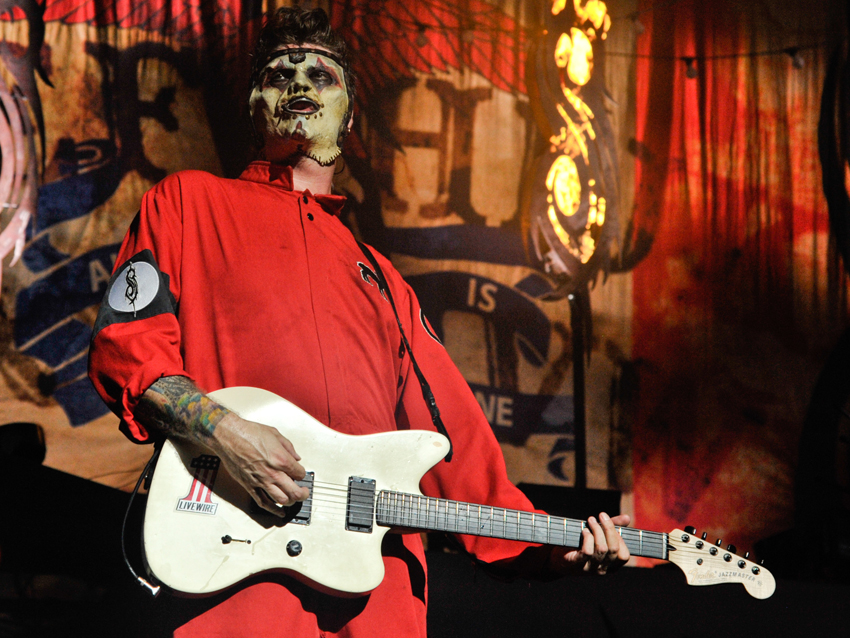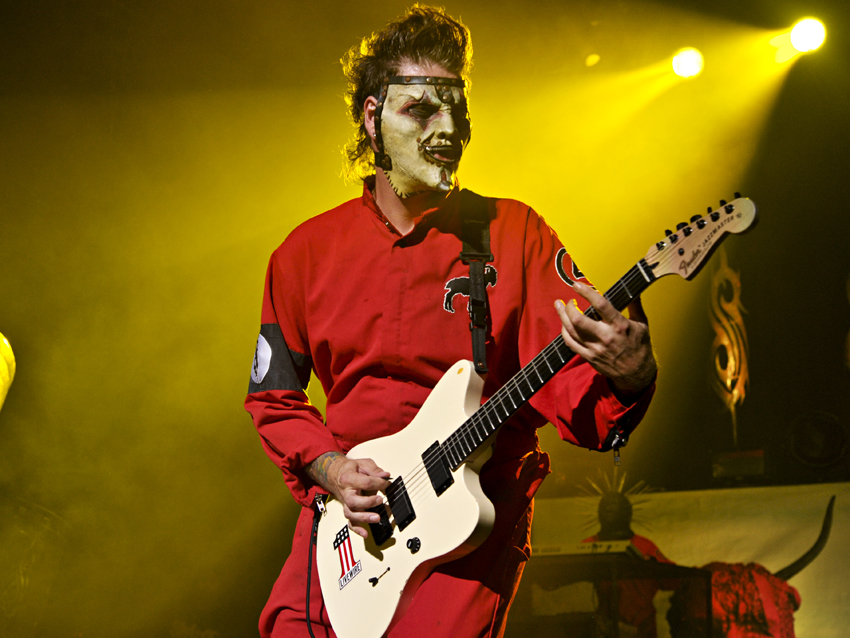
Slipknot's Jim Root: my top 5 tips for guitarists
ELECTRIC GUITAR WEEK: A lot has changed in the world of Slipknot since Jim Root joined in 1999, but the recent chart-topping success of album We Are Not Your Kind proves their ability to adapt in the face of adversity continues to pay dividends.
The guitarist is a huge part of that. Alongside Mick Thomson, he's proven himself a vital creative force in the band. One who continues to evolve on each of the Iowa metal outfit's albums.
Root also has valuable advice to offer other players, as we find out when he runs down his top five tips for guitarists.
Electric Guitar Week is brought to you in association with Fender. Check out the Electric Guitar Week hub page for more tips and tutorials.

Get a guitar that you love
“For one reason or another, a lot of guys wind up with a guitar that isn’t really right for them. The guitar can be kind of close, but something about it is just a little off. And when that happens, you don’t feel inspired by the guitar. It kills your ambition.
"On the other hand, if you find a guitar that you really love and it just feels totally right, you’ll be more apt to want to play it; you won't wanna put the thing down. And, of course, we know what happens then: You’ll become a better player, because the whole act of practicing won’t feel like work – it'll be fun.
“My first guitar was a Takamine that my dad got me. I loved it and just couldn’t put the thing down. It just worked for me. So really, just make sure that whatever you get that you’re happy with it. Don’t shortchange yourself. It doesn’t have to be the most expensive guitar in the world; it just has to be the guitar that's meant for you."

Warm up
“I’ll admit that I don’t have a lot of discipline when it comes to practicing. I’m not the type of guy who sits at home with a metronome and runs through scales and stuff like that. But I do go through phases when I’ll be more diligent, and I notice that warming up and working on some patterns will make my playing cleaner.
“On tour I’m probably more into practicing. I’ll sit backstage or on the bus with a little amp, and I’ll run through scales to warm my fingers up. I’m at the point now where I’ve learned all of the three-note-per-string Paul Gilbert scales. Only thing is, I learned them all in one position; it never occurred to me to move them around the fretboard, which can help when you’re trying to stay in key to a particular song.
“That was a right 'light-going-on-over-my-head' moment. So now, I’ll work those scales and move them around. It’s really easy for me to rip them in one position – I don’t even have to look at the guitar – but playing them in different places on the neck takes some doing. It’s good warm-up stuff.”

Buy the right amp
“It’s easy to get a good amp that might not be the right amp for you. When you go to a music store, really turn the amps on and turn ‘em up – hopefully they’ll let you – and work through the sounds. This is an important decision, so take your time and be methodical.
“It can be a very personal thing, the right amp that makes the right sound. Sometimes it’s all about hitting that one note that makes you go, ‘That’s it. That’s the sound I’ve been looking for.’ When you hear an amp give that sound back to you, it’ll make you wanna keep playing.
“Finding the right amp can be a process, especially when you’re young and just starting out. When I was a kid, I had to rely on whatever I got for Christmas. Then my mom got me a Peavey VTM 120. I used that for a few years. After that, I took everything I had, sold it all, and I saved all the money I made from washing dishes to get a Mesa/Boogie amp.
“But back then, I had to rely on what everybody told me about amps. Now you can go on YouTube or different manufacturer’s websites and actually hear what things sound like. So do your homework and check things out. But when you actually go to a store and test amps out, really take your time to be sure of what you’re buying.”

Pack light for gigs
“I not really into modeling amps, but on the other hand, if you’re just starting out playing gigs and you don’t have people helping you, you might want to try one of those things out. It beats hauling a big heavy head and a pair of speaker cabinets around with you.
“Or try a good combo amp. You can get a decent Peavey 5150 that sounds absolutely raging. As long as you’ve got a good sound and monitor guy, you’ll sound incredible, and you’ll be able to hear what you’re doing just fine.
“Just keep it simple, especially if you’re just getting your feet wet with playing out. Even today, I try not to overcomplicate things. I’ve got a rack and a couple of heads, but I’m running everything off of one head into an iso cabinet; the other head is there as a backup. And I use pedals straight into the front of the amp. I do use a GCX switching system, which is like a true bypass for the effects, and I can program different combinations and do channel switching, but it’s essentially just like having a pedalboard in front of me. The cleanest, straightest path you have from your guitar to the amp is always the best.”

Just get going
“There’s no one way to do anything in music. There are no rules; there are no written instructions to follow. So whatever you want to do, just get going. I started out playing with different drummers in basements before there was even a band. It didn't matter, though, because I was already on my way.
“Play with people who are better than you. That's something else I'd recommend. Up your game. It might be a little daunting at first, but there’s no better kick in the ass than by striving to get to the level of some other guys. The first band I was in was a speed metal band, and the other guitarist was the guy who was teaching me how to play. He was four years older and could rip all over the fretboard. The only thing I could do was try to keep up.
"So give yourself a challenge, and you know, just get on with it.”
Joe is a freelance journalist who has, over the past few decades, interviewed hundreds of guitarists for Guitar World, Guitar Player, MusicRadar and Classic Rock. He is also a former editor of Guitar World, contributing writer for Guitar Aficionado and VP of A&R for Island Records. He’s an enthusiastic guitarist, but he’s nowhere near the likes of the people he interviews. Surprisingly, his skills are more suited to the drums. If you need a drummer for your Beatles tribute band, look him up.
